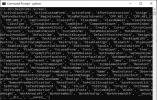What Is The DelphiVCL.Screen or TScreen Object?
By Muhammad Azizul Hakim December 15, 2021
DelphiVCL.Screen or TScreen represents the state of the screen in which an application runs.
TScreen introduces properties that specify:
TScreen effectively handles the layout of the application’s user interface on multiple monitors. If your application runs on multiple monitors, the Monitors property maintains a list of monitors used to comprise the desktop, coordinates, and dimensions of monitors. The MonitorCount property returns the number of monitors. See also Handling the Screen.
Let’s browse all the properties and methods of the DelphiVCL.Screen using dir() command:
See the responses in the Windows command prompt:

You can also read short information about the DelphiVCL.Screen using the print() command:
Here the responses in the Windows command prompt window:

By Muhammad Azizul Hakim December 15, 2021
DelphiVCL.Screen or TScreen represents the state of the screen in which an application runs.
TScreen introduces properties that specify:
- What forms and data modules have been instantiated by the application.
- The active form, and the active control within that form.
- The size and resolution of the screen.
- The cursors and fonts are available for the application to use.
- The list of monitors on which the application’s forms can appear, including their dimensions.
TScreen effectively handles the layout of the application’s user interface on multiple monitors. If your application runs on multiple monitors, the Monitors property maintains a list of monitors used to comprise the desktop, coordinates, and dimensions of monitors. The MonitorCount property returns the number of monitors. See also Handling the Screen.
Let’s browse all the properties and methods of the DelphiVCL.Screen using dir() command:
Python:
import DelphiVCL
dir(DelphiVCL.Screen)
You can also read short information about the DelphiVCL.Screen using the print() command:
Python:
print(DelphiVCL.Screen)
print(DelphiVCL.Screen.__doc__)
